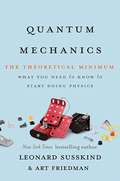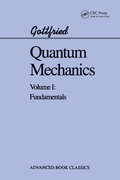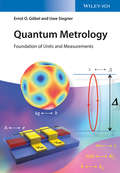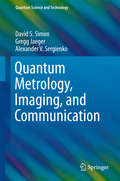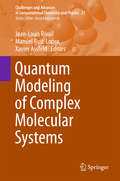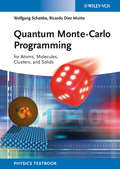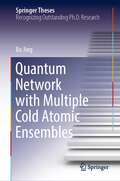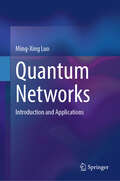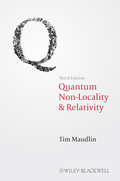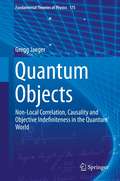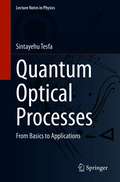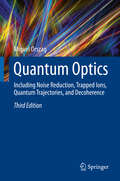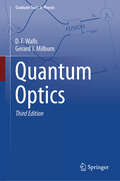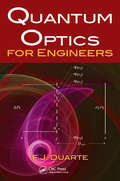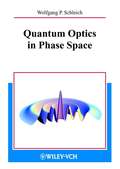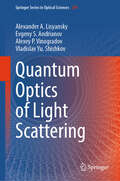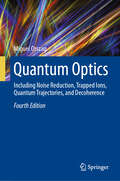- Table View
- List View
Quantum Mechanics: The Theoretical Minimum (The Theoretical Minimum)
by Leonard Susskind Art FriedmanFrom the bestselling author of The Theoretical Minimum, an accessible introduction to the math and science of quantum mechanicsQuantum Mechanics is a (second) book for anyone who wants to learn how to think like a physicist. In this follow-up to the bestselling The Theoretical Minimum, physicist Leonard Susskind and data engineer Art Friedman offer a first course in the theory and associated mathematics of the strange world of quantum mechanics. Quantum Mechanics presents Susskind and Friedman's crystal-clear explanations of the principles of quantum states, uncertainty and time dependence, entanglement, and particle and wave states, among other topics. An accessible but rigorous introduction to a famously difficult topic, Quantum Mechanics provides a tool kit for amateur scientists to learn physics at their own pace.
Quantum Mechanics: Volume 1: Fundamentals (Graduate Texts In Contemporary Physics Series)
by Kurt GottfriedThis book contains discussions of radiation theory, quantum statistics and the many-body problem, and more advanced topics in collision theory. It is intended as a text for a first-year graduate quantum mechanics course.
Quantum Metrology
by Uwe Siegner Ernst O. GoebelThe International System of Units (SI) is the world's most widely used system of measurement, used every day in commerce and science, and is the modern form of the metric system. It currently comprises the meter (m), the kilogram (kg), the second (s), the ampere (A), the kelvin (K), the candela (cd) and the mole (mol)). The system is changing though, units and unit definitions are modified through international agreements as the technology of measurement progresses, and as the precision of measurements improves. The SI is now being redefined based on constants of nature and their realization by quantum standards. Therefore, the underlying physics and technologies will receive increasing interest, and not only in the metrology community but in all fields of science. This book introduces and explains the applications of modern physics concepts to metrology, the science and the applications of measurements. A special focus is made on the use of quantum standards for the realization of the forthcoming new SI (the international system of units). The basic physical phenomena are introduced on a level which provides comprehensive information for the experienced reader but also provides a guide for a more intense study of these phenomena for students.
Quantum Metrology, Imaging, and Communication
by Gregg Jaeger David S. Simon Alexander V. SergienkoThis book describes the experimental and theoretical bases for the development of specifically quantum-mechanical approaches to metrology, imaging, and communication. In particular, it presents novel techniques developed over the last two decades and explicates them both theoretically and by reference to experiments which demonstrate their principles in practice. The particular techniques explored include two-photon interferometry, two-photon optical aberration and dispersion cancellation, lithography, microscopy, and cryptography.
Quantum Microscopy of Biological Systems
by Michael TaylorThis thesis reports on the development of the first quantum enhanced microscope and on its applications in biological microscopy. The first quantum particle-tracking microscope, described in detail here, represents a pioneering advance in quantum microscopy, which is shown to be a powerful and relevant technique for future applications in science and medicine. The microscope is used to perform the first quantum-enhanced biological measurements -- a central and long-standing goal in the field of quantum measurement. Sub diffraction-limited quantum imaging is achieved, also for the first time, with a scanning probe imaging configuration allowing 10-nanometer resolution.
Quantum Mind: The Edge Between Physics and Psychology
by Arnold MindellBy exploring principles found in psychology, math, physics, and shamanism, it becomes possible to link a cosmic perspective with ordinary life.
Quantum Modeling of Complex Molecular Systems
by Jean-Louis Rivail Manuel Ruiz-Lopez Xavier AssfeldThis multi-author contributed volume includes methodological advances and original applications to actual chemical or biochemical phenomena which were not possible before the increased sophistication of modern computers. The chapters contain detailed reviews of the developments of various computational techniques, used to study complex molecular systems such as molecular liquids and solutions (particularly aqueous solutions), liquid-gas, solid-gas interphase and biomacromolecular systems. Quantum modeling of complex molecular systems is a useful resource for graduate students and fledgling researchers and is also an excellent companion for research professionals engaged in computational chemistry, material science, nanotechnology, physics, drug design, and molecular biochemistry.
Quantum Models of Cognition and Decision
by Jerome R. Busemeyer Peter D. BruzaMuch of our understanding of human thinking is based on probabilistic models. This innovative book by Jerome R. Busemeyer and Peter D. Bruza argues that, actually, the underlying mathematical structures from quantum theory provide a much better account of human thinking than traditional models. They introduce the foundations for modelling probabilistic-dynamic systems using two aspects of quantum theory. The first, 'contextuality', is a way to understand interference effects found with inferences and decisions under conditions of uncertainty. The second, 'quantum entanglement', allows cognitive phenomena to be modeled in non-reductionist ways. Employing these principles drawn from quantum theory allows us to view human cognition and decision in a totally new light. Introducing the basic principles in an easy-to-follow way, this book does not assume a physics background or a quantum brain and comes complete with a tutorial and fully worked-out applications in important areas of cognition and decision.
Quantum Monte Carlo Approaches For Correlated Systems
by Federico Becca Sandro SorellaOver the past several decades, computational approaches to studying strongly-interacting systems have become increasingly varied and sophisticated. This book provides a comprehensive introduction to state-of-the-art quantum Monte Carlo techniques relevant for applications in correlated systems. Providing a clear overview of variational wave functions, and featuring a detailed presentation of stochastic samplings including Markov chains and Langevin dynamics, which are developed into a discussion of Monte Carlo methods. The variational technique is described, from foundations to a detailed description of its algorithms. Further topics discussed include optimisation techniques, real-time dynamics and projection methods, including Green's function, reptation and auxiliary-field Monte Carlo, from basic definitions to advanced algorithms for efficient codes, and the book concludes with recent developments on the continuum space. Quantum Monte Carlo Approaches for Correlated Systems provides an extensive reference for students and researchers working in condensed matter theory or those interested in advanced numerical methods for electronic simulation.
Quantum Monte-Carlo Programming: For Atoms, Molecules, Clusters, and Solids
by Wolfgang Schattke Ricardo Díez MuiñoQuantum Monte Carlo is a large class of computer algorithms that simulate quantum systems to solve many body systems in order to investigate the electronic structure of many-body systems. <P><P>This book presents a numeric approach to determine the electronic structure of atoms, molecules and solids. Because of the simplicity of its theoretical concept, the authors focus on the variational Quantum-Monte-Carlo (VQMC) scheme. The reader is enabled to proceed from simple examples as the hydrogen atom to advanced ones as the Lithium solid. Several intermediate steps cover the Hydrogen molecule, how to deal with a two electron systems, going over to three electrons, and expanding to an arbitrary number of electrons to finally treat the three-dimensional periodic array of Lithium atoms in a crystal. The exmples in the field of VQMC are followed by the subject of diffusion Monte-Calro (DMC) which covers a common example, the harmonic ascillator. The book is unique as it provides both theory and numerical programs. It includes rather practical advices to do what is usually described in a theoretical textbook, and presents in more detail the physical understanding of what the manual of a code usually promises as result. Detailed derivations can be found at the appendix, and the references are chosen with respect to their use for specifying details or getting an deeper understanding .The authors address an introductory readership in condensed matter physics, computational phyiscs, chemistry and materials science. As the text is intended to open the reader's view towards various possibilities of choices of computing schemes connected with the method of QMC, it might also become a welcome literature for researchers who would like to know more about QMC methods. The book is accompanied with a collection of programs, routines, and data.
Quantum Nano-Plasmonics
by Witold A. JacakWith examples and clear explanation throughout, this step-by-step approach makes quantum theory of plasmons accessible to readers without specialized training in theory. Jacak uses original research results to offer a fully analytical theory formulation suitable for further development and applications. The theory is focused on the Random Phase Approximation description of plasmons in metallic nano-structures, previously defined for bulk metal. Particular attention is paid to large damping of plasmons in nanostructures including electron scattering and Lorentz friction losses, quantum description of plasmon photovoltaic effect is presented and there is in-depth analysis of plasmon-polariton kinetics in metallic nano-chains. Suitable for students in the field of plasmonics, opto-electronics and photonics, and for researchers active in the field of photo-voltaics, opto-electronics, nano-plasmonics and nano-photonics. Also of help to researchers in soft plasmonics with applications to electro-signalling in neurons.
Quantum Network with Multiple Cold Atomic Ensembles (Springer Theses)
by Bo JingThis book highlights the novel research in quantum memory networking, especially quantum memories based on cold atomic ensembles. After discussing the frontiers of quantum networking research and building a DLCZ-type quantum memory with cold atomic ensemble, the author develops the ring cavity enhanced quantum memory and demonstrates a filter-free quantum memory, which significantly improves the photon-atom entanglement. The author then realizes for the first time the GHZ-type entanglement of three separate quantum memories, a building block of 2D quantum repeaters and quantum networks. The author also combines quantum memories and time-resolved measurements, and reports the first multiple interference of three single photons with different colors. The book is of good reference value for graduate students, researchers, and technical personnel in quantum information sciences.
Quantum Networks: Introduction and Applications
by Ming-Xing LuoThis book provides a comprehensive overview of the rapidly advancing research in quantum networks, both in theory and application. While the classical internet has become essential in our daily lives, its communication techniques have limitations, such as vulnerability to interception and eavesdropping. Quantum networks, by transmitting quantum qubits, address these security concerns using the principles of quantum mechanics, such as superposition, no-cloning, and Heisenberg uncertainty. Kimble first proposed the concept of a quantum internet in 2008, envisioning a network that harnesses quantum devices and laws to transmit information. Wehner and colleagues reviewed the steps necessary to achieve a quantum internet in 2018, outlining development stages leading to increasingly powerful applications. While a fully functional quantum internet is still in progress, significant advances have been made through experiments, such as satellite-based quantum key distribution networks and quantum metropolitan area networks. This book aims to provide a unified theoretical framework for students and researchers interested in the quantum internet, offering insights into topics like network communication theory, secure communication, distributed computation, nonlocality, and quantum configuration. By presenting cutting-edge research and potential applications in the field of quantum information processing, including the quantum internet, this book stands out as a valuable resource for beginners, undergraduate students, graduate students, and researchers in physics, computer science, and information science. It bridges the gap between theoretical perspectives and practical applications, offering a comprehensive guide to the exciting possibilities of quantum networks.
Quantum Non-Locality and Relativity: Metaphysical Intimations of Modern Physics (Aristotelian Society Monographs #1)
by Tim MaudlinThe third edition of Quantum Non-Locality and Relativity has been carefully updated to reflect significant developments, including a new chapter covering important recent work in the foundations of physics. A new edition of the premier philosophical study of Bell’s Theorem and its implication for the relativistic account of space and time Discusses Roderich Tumiulka’s explicit, relativistic theory that can reproduce the quantum mechanical violation of Bell’s inequality. Discusses the "Free Will Theorem" of John Conway and Simon Kochen Introduces philosophers to the relevant physics and demonstrates how philosophical analysis can help inform physics
Quantum Nonlocality and Reality
by Mary Bell Shan GaoCombining twenty-six original essays written by an impressive line-up of distinguished physicists and philosophers of physics, this anthology reflects some of the latest thoughts by leading experts on the influence of Bell's theorem on quantum physics. Essays progress from John Bell's character and background, through studies of his main work, and on to more speculative ideas, addressing the controversies surrounding the theorem, and investigating the theorem's meaning and its deep implications for the nature of physical reality. Combined, they present a powerful comment on the undeniable significance of Bell's theorem for the development of ideas in quantum physics over the past 50 years. Questions surrounding the assumptions and significance of Bell's work still inspire discussion in the field of quantum physics. Adding to this with a theoretical and philosophical perspective, this balanced anthology is an indispensable volume for students and researchers interested in the philosophy of physics and the foundations of quantum mechanics.
Quantum Objects: Non-Local Correlation, Causality and Objective Indefiniteness in the Quantum World
by Gregg JaegerThis monograph identifies the essential characteristics of the objects described by current quantum theory and considers their relationship to space-time. In the process, it explicates the senses in which quantum objects may be consistently considered to have parts of which they may be composed or into which they may be decomposed. The book also demonstrates the degree to which reduction is possible in quantum mechanics, showing it to be related to the objective indefiniteness of quantum properties and the strong non-local correlations that can occur between the physical quantities of quantum subsystems. Careful attention is paid to the relationships among such property correlations, physical causation, probability, and symmetry in quantum theory. In this way, the text identifies and clarifies the conceptual grounds underlying the unique nature of many quantum phenomena.
Quantum Optical Processes: From Basics to Applications (Lecture Notes in Physics #976)
by Sintayehu TesfaThis book is a self-contained guide to the world of quantum optical processes which addresses different aspects relevant in quantum optics and quantum information. The basic descriptions, measurement techniques, possible sources, nonclassical features, practical implications and applications of the quantization of light and its interaction with matter, are explored. The observed quantum properties such as coherent superposition, entanglement, nonlocality, decoherence and no-cloning, are discussed. The quantum optical processes such as continuous variable entanglement swapping, teleportation and telecloning from which follow the practical aspects such as quantum gate operations, cryptography and error correction are considered. In turn, the advantages and inherent challenges including the foresight in implementing continuous variable quantum communication and computation protocols are highlighted. The author gives a concise background with corresponding applications, the necessary mathematical derivation, simplified examples, illustrations and demonstrations, and the relative interpretations and outlooks. This book is intended to serve a multi-disciplinary readership, namely the atomic physics and quantum optics communities who seek to extend their research to applications, especially, to the field of quantum information processing as well as the theoretical quantum information community who builds up research on physically realizable systems such as optical setups and various atomic schemes. The content of this book also attracts other communities such as photonics who seeks to link research with continuous variable quantum information processing.
Quantum Optics
by Girish S. AgarwalIn the last decade many important advances have taken place in the field of quantum optics, with numerous potential applications. Ideal for graduate courses on quantum optics, this textbook provides an up-to-date account of the basic principles of the subject. Focusing on applications of quantum optics, the textbook covers recent developments such as engineering of quantum states, quantum optics on a chip, nano-mechanical mirrors, quantum entanglement, quantum metrology, spin squeezing, control of decoherence and many other key topics. Readers are guided through the principles of quantum optics and their uses in a wide variety of areas including quantum information science and quantum mechanics. The textbook features end-of-chapter exercises with solutions available for instructors at www. cambridge. org/9781107006409. It is invaluable to both graduate students and researchers in physics and photonics, quantum information science and quantum communications.
Quantum Optics
by Miguel OrszagThis new edition gives a unique and broad coverage of basic laser-related phenomena that allow graduate students, scientists and engineers to carry out research in quantum optics and laser physics. It covers quantization of the electromagnetic field, quantum theory of coherence, atom-field interaction models, resonance fluorescence, quantum theory of damping, laser theory using both the master equation and the Langevin theory, the correlated emission laser, input-output theory with applications to non-linear optics, quantum trajectories, quantum non-demolition measurements and generation of non-classical vibrational states of ions in a Paul trap. In this third edition, there is an enlarged chapter on trapped ions, as well as new sections on quantum computing and quantum bits with applications. There is also additional material included for quantum processing and entanglement. These topics are presented in a unified and didactic manner, each chapter is accompanied by specific problems and hints to solutions to deepen the knowledge.
Quantum Optics (Graduate Texts in Physics)
by Gerard J. Milburn D. F. WallsThis graduate textbook unifies the presentation of new and well-established basic theory and experiments for the quantum properties of light. Quantum optics has become a major field of theoretical and experimental physics. Many of the key tests of unique quantum phenomena, such as entanglement, have been demonstrated in quantum optics experiments. It forms the basis of many quantum technologies from sensing to computation. This completely revised third edition enables graduate students to acquire a deep knowledge of contemporary quantum optics and its relevance for quantum technology. New experimental developments are discussed, alongside the relevant theory. New chapters on quantum control, quantum opto-mechanics, quantum communication and computation have been added. Numerous exercises help readers test their understanding and provide practice in quantitative problem solving.
Quantum Optics for Engineers
by F.J. DuarteQuantum Optics for Engineers provides a transparent and methodical introduction to quantum optics via the Dirac's bra–ket notation with an emphasis on practical applications and basic aspects of quantum mechanics such as Heisenberg's uncertainty principle and Schrodinger's equation. Self-contained and using mainly first-year calculus and algebra tools, the book: Illustrates the interferometric quantum origin of fundamental optical principles such as diffraction, refraction, and reflection Provides a transparent introduction, via Dirac's notation, to the probability amplitude of quantum entanglement Explains applications of the probability amplitude of quantum entanglement to optical communications, quantum cryptography, quantum teleportation, and quantum computing. Quantum Optics for Engineers is succinct, transparent, and practical, revealing the intriguing world of quantum entanglement via many practical examples. Ample illustrations are used throughout its presentation and the theory is presented in a methodical, detailed approach.
Quantum Optics for Engineers: Quantum Entanglement
by F.J. DuarteThe second edition of Quantum Optics for Engineers: Quantum Entanglement is an updated and extended version of its first edition. New features include a transparent interferometric derivation of the physics for quantum entanglement devoid of mysteries and paradoxes. It also provides a utilitarian matrix version of quantum entanglement apt for engineering applications.Features: Introduces quantum entanglement via the Dirac–Feynman interferometric principle, free of paradoxes. Provides a practical matrix version of quantum entanglement which is highly utilitarian and useful for engineers. Focuses on the physics relevant to quantum entanglement and is coherently and consistently presented via Dirac’s notation. Illustrates the interferometric quantum origin of fundamental optical principles such as diffraction, refraction, and reflection. Emphasizes mathematical transparency and extends on a pragmatic interpretation of quantum mechanics. This book is written for advanced physics and engineering students, practicing engineers, and scientists seeking a workable-practical introduction to quantum optics and quantum entanglement.
Quantum Optics in Phase Space
by Wolfgang P. SchleichQuantum Optics in Phase Space provides a concise introduction to the rapidly moving field of quantum optics from the point of view of phase space. Modern in style and didactically skillful, Quantum Optics in Phase Space prepares students for their own research by presenting detailed derivations, many illustrations and a large set of workable problems at the end of each chapter. Often, the theoretical treatments are accompanied by the corresponding experiments. An exhaustive list of references provides a guide to the literature. Quantum Optics in Phase Space also serves advanced researchers as a comprehensive reference book. Starting with an extensive review of the experiments that define quantum optics and a brief summary of the foundations of quantum mechanics the author Wolfgang P. Schleich illustrates the properties of quantum states with the help of the Wigner phase space distribution function. His description of waves ala WKB connects semi-classical phase space with the Berry phase. These semi-classical techniques provide deeper insight into the timely topics of wave packet dynamics, fractional revivals and the Talbot effect. Whereas the first half of the book deals with mechanical oscillators such as ions in a trap or atoms in a standing wave the second half addresses problems where the quantization of the radiation field is of importance. Such topics extensively discussed include optical interferometry, the atom-field interaction, quantum state preparation and measurement, entanglement, decoherence, the one-atom maser and atom optics in quantized light fields. Quantum Optics in Phase Space presents the subject of quantum optics as transparently as possible. Giving wide-ranging references, it enables students to study and solve problems with modern scientific literature. The result is a remarkably concise yet comprehensive and accessible text- and reference book - an inspiring source of information and insight for students, teachers and researchers alike.
Quantum Optics of Light Scattering (Springer Series in Optical Sciences #249)
by Alexey P. Vinogradov Alexander A. Lisyansky Evgeny S. Andrianov Vladislav Yu. ShishkovThis book presents a quantum framework for understanding inelastic light scattering which is consistent with the classical descriptions of Raman phenomena and Rayleigh scattering, thus creating a unified theoretical picture of light scattering. The Raman effect was discovered in 1928 and has since proved to be one of the most powerful tools to study the molecular structure of gases, liquids, and crystals. The subsequent development of new scientific disciplines such as nonlinear optics, quantum optics, plasmonics, metamaterials, and the theory of open quantum systems has changed our views on the nature of Rayleigh and Raman scattering. Today, there are many excellent books on the theory and applications of light scattering, but a consistent description of light scattering from a unified viewpoint is missing. The authors’ approach has the power to re-derive the results of both classical and quantum approaches while also addressing many questions that are scattered acrossthe research literature: Why is Rayleigh scattering coherent while Raman scattering is not, although both phenomena are caused by the incidence of a coherent wave? Why are coherent Stokes and coherent anti-Stokes Raman scattering caused by two coherent incident waves both always coherent? This book answers these questions and more, and explains state-of-the-art experimental results with a first-principles approach that avoids phenomenological arguments. Many of the results presented are appearing in book form for the first time, making this book especially useful for young researchers entering the field. The book reviews basic concepts of quantum mechanics and quantum optics and comes equipped with problems and solutions to develop understanding of the key mathematical techniques. The rigorous approach presented in the book is elegant and readily grasped, and will therefore prove useful to both theorists and experimentalists at the graduate level and above, as well as engineers who useRaman scattering methods in their work.
Quantum Optics: Including Noise Reduction, Trapped Ions, Quantum Trajectories, and Decoherence
by Miguel OrszagThis revised new edition gives a unique and broad coverage of basic laser-related phenomena that allow graduate students, scientists and engineers to carry out research in quantum optics and laser physics. It covers quantization of the electromagnetic field, quantum theory of coherence, atom-field interaction models, resonance fluorescence, quantum theory of damping, laser theory using both the master equation and the Langevin theory, the correlated emission laser, input-output theory with applications to non-linear optics, quantum trajectories, quantum non-demolition measurements and generation of non-classical vibrational states of ions in a Paul trap. This fourth edition provides a new chapter on weak measurement, as well as a new chapter on complementarity. There is also new material included for atom optics and new problems have been added. Each topic is presented in a unified and didactic manner, and is accompanied by specific problems and hints to solutions to deepen the knowledge.
